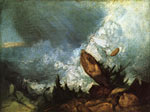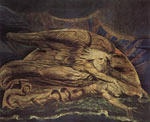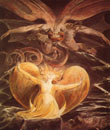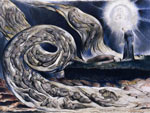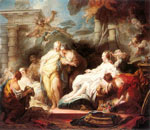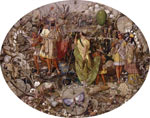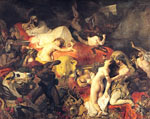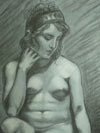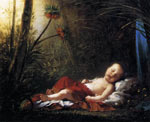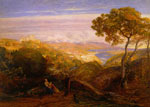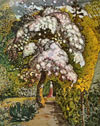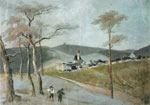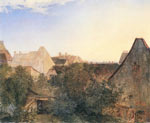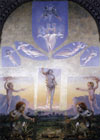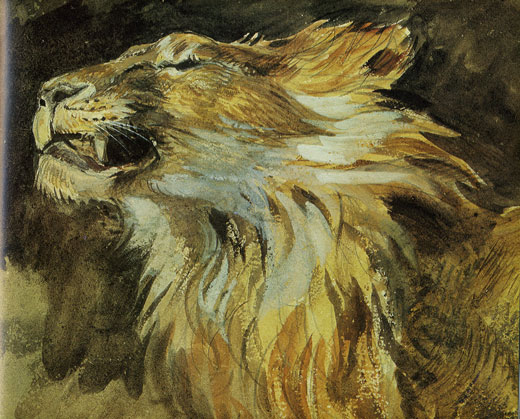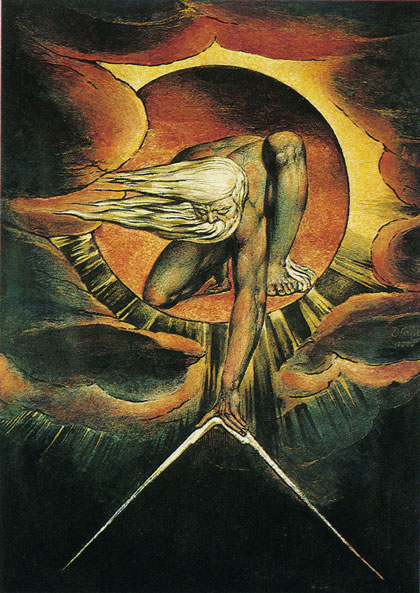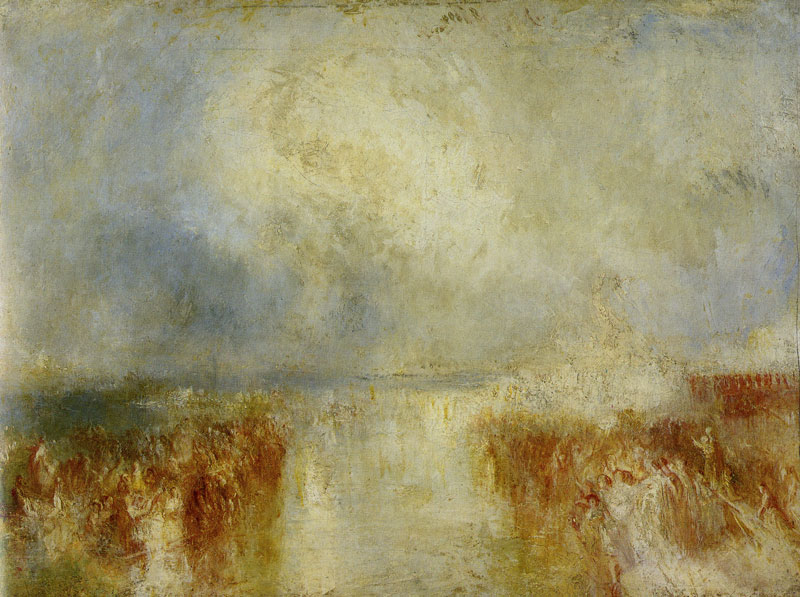
Moving Movements, History of Modern Painting, Before 1840
RENOVATIONS IN PAINTING, END 18TH CENTURY
The 17th and 18the century were the period of Enlightment, which had its roots in the old Greek Philosophy and the renaissance. In 1687 Isaac Newton formulated his three laws of movement and the law of universal gravity in "Philosophiae Naturalis Mathematica", better known as "Principia". In 1769 Richard Arkwright got patent on a hydraulic spinning machine too big and too expensive to stand in a house. So he is considered to be the founder of the first factory. In 1781 Immanuel Kant published his "Kritik der reinen Vernunft", the start of rationalism.
click the thumbnails
William J. M. Turner
The Fall of an Avalanche
in the Grisons 1810
William Blake
Elohim creating Adam
William Blake
The great red Dragon
William Blake
The wirlwind of Lovers
Caspar David Friedrich
Abbey in the Oak Forest
Caspar David Friedrich
Winter Landscape
Caspar David Friedrich
The Lake of Ice
Jacques- Louis David
Brutus
Jean Honore Fragonard
Psyche showing her Sisters
her Gifts from Cupid
Richard Dadd
The Fairy Feller's Masterstroke
Richard Dadd
Contradiction
Eugène Dalacroix
The Dead of Sardanapale
Pierre-Paul Prud'hon
Ladytop
Pierre-Paul Prud'hon
Portrait of the King of Rome
Samuel Palmer
The Prospect
Samuel Palmer
Garden in Shoreham
Samuel Palmer
Cornfield in Moonlight
Samuel Palmer
After the Evening Service
Adalbert Stifter
Friedberg and the Ruin Wittinghousen
Adalbert Stifter
Suburb Hauses
Philipp Otto Runge
The great Morning
Eugène Delacroix, fragment from "Tête de Lion", 1843 |
From baroque until the 19th century paintings were subjected to strict standards. Not only it was obliged to paint to nature, but it was also prescribed which colours should be used, which subjects were accepted, which poses people had, how they turn their faces for a portrait, and so on... The result was an art of formality, monotony and dull colours: bible scenes, ruins, heroic events, military situations, moralising scenes, baroque interiors, boring portraits or mythological reunions. Reality was not depicted correctly, it was idealised. History often got a switch. Nature was made duller not to catch too much attention, human figures were deprived of all sensuality. Few painters strike us by beauty of originality, exceptions are Rembrandt and Vermeer. |
Compared with the rich colouring and the joy of living in the renaissance, baroque was a regression. Even the gothic had its gold and wonderful colours, as well as miniatures full of fantasy and naive expression. In those times standards were more locally prescribed. The Renaissance was a relief from the standards of the gothic, in subjects as well as in style. For example the "Lamb of God" of Van
Eyck is not inferior to even Rembrandt.
Farther South, the religious scenes of El Greco were very distinct, in colour as well in form. The face expression and the bodily distortions can be regarded as expressionism. To give another example: also Tintoret had his own colours, light effects and dramatic poses, a personal style and expressivity, full of movement.
Jeroen Bosch painted pure surrealism, a specific fantasy world, and Brueghel de Oude did put a special mood in his landscapes, which none of the other Brueghel's succeeded.
Also in pure technique baroque was a regression. A lot of knowledge was lost and certain colours could not be made anymore. As a result of darkening, their red and umber are now more obscure then they were in that period. The whole of western culture, with its imperialism, dynasties,
militarism and puritanism, its gloomy vision on life and listlessness are reflected in the then art. Large works were mostly made on command and had a particular function to fulfil.
A lot of painters were in permanent appointment. Hence the many austere portraits, the inaugurations, battle scenes, hunt scenes, still lifes with hunt trophies...
William Blake, Ancient of Days, 1794 |
In
the 18th and 19th century the small work of those painters look much more interesting to us: sketches, studies, drawings... They didn't make them in assignment, but for themselves. Not only as a preparation for the pathetic work, but even for the pleasure of making. That's why those works do not obey the standards. Also Rubens made some really beautiful oil sketches. In the second halve of the 18th century some painters made interesting lavis paintings. The motifs were classical: Greek-Roman, religious or moralising themes, but in a very "modern" style.
They also used several creative techniques: washing out, hatching, fine lines close to large brush strokes, sometimes freely swarming lines. Examples are Greuze, Füssli and
Jefferys. Studies of George Romney from the end of the 18th century (a portrait painter) could be regarded as modern art: quick sketches, scarcely recognisable subjects. The beauty of the spontaneous brush stroke, with its freshness and expression, mainly remained untouched in their sketches and studies. But even
Jacques-Louis David already let spontaneous brush strokes unprocessed on his paintings. Till the end of the 18th century a few artists freed themselves from the strangling straitjacket of standards en did search a way to real beauty and expression, such as William Blake and William Turner. Blake painted his "visionary" scenes only in watercolour, because, according to him, it suits better to mystical expression. In that time oil was regarded as far superior to other mediums. |
Turner got famous by his precise landscapes. But for his own sake he made a lot of quick sketches in watercolour with little figuration to almost abstract, with colours flowing out, diverse colour areas supposed to each other, quick silhouettes...
THE BEGINNING OF THE 19TH CENTURY
In
1807 the first steam boat was in the run. In 1825 George Stephenson made with his "Locomotion
No.1" his first travel. After 1830 Stephenson's locomotive became well used.
Between 1850 and 1900 thousands of kilometres of railway were constructed. In 1852 the first airship flew with a steam engine. In 1837
Samuel
Finley Breese Morse got patent on a more practical version of the telegraph, with the famous code of stripes and dots. In
1854 Paris and London were interconnected with the telegraph. The daguerreotype,
a new procedure to make photos in 3D, was presented by
Louis-Jaques Daguerre.
In
1852-54 Livingstone arrived at the Victoria waterfalls. The digging of the Suez Canal was finished in 1869.
In 1840 Wien dispensed with slavery, Russia and Poland in 1861. In 1848
there came liberal reformations in Germany, as well as a revolt in Italy against the oppression of Austria. In 1861 the American civil war begun under Lincoln, slavery was forbidden in 1865. In 1859
Darwin's "Origin of Species" was edited and in 1871 his "Descent of man".
In 1862 the first world exposition took place in London.
J.M.W. Turner, Feast Lagune Scene, 1845 |
The 19th century started, the age of industrialisation. The metal industry arose, blackening the fast growing cities. The bourgeoisie developped, flaunting with their possessions. In 1820 the first department stores arose in Paris. There were also slums and child labour. Charity and prisons were growing, as alcoholism and prostitution. The first social revolts were bloodily suppressed. In 1830 the revolution broke loose, the liberals and lower middle class were the winners. The photography arose quickly. In 1816 N. Niepce made the first paper photo from his window. In 1827 he makes the first direct positive, lightfast (Heliogravure of photogravure).
A lot of paintings were of little value: idealist works to flatter or please the bourgeoisie, with mythological scenes of low level, such as painted by
Girodet, Guérin, Gerard. Chassériau continued this way of working until the years '40. Nevertheless there are a few rays of hope: Caspar David Friedrich painted precise landscapes in such a way it emanates a mystery, what makes his work symbolism!
Jean Honore Fragonard used more colour then his colleagues, is less precise, let strikes exist and paints a beautiful play of light with sun spots.
But above all Turner is unique in his playing with sunlight, fire or fog. In the years '20 and '30 he painted sometimes totally abstract. His "colour structure
19" for example is nothing but three coloured bands above each other, we will only see such a style returning in the years of the pop-art! He also painted hardly recognisable interiors. His playing with light now also comes visible in his oils, such as the painting of the fire in the parliement in 1834. The event is not anymore the topic, but the opportunity to make an almost abstract painting full of light effects. In such a way his "Snowstorm
with Hannibal's Army" is largely a turbulent arch of heaven in an abstract feast.
Turner is often wrongly labelled as the "forerunner of impressionism". His work was a revolution compared with his colleagues, but in a very personal direction, more going towards expression and abstraction, very far from the technique of the future impressionists.
One of the few future painters using a similar technique to Turner's, will be Ensor in his "visions". But Turner also did go on making his very precise landscapes, from which he got his reputation and his income. His special works were regarded as follies.
We already mentioned Blake. In 1824, three years before his death, he painted "Paolo and Francisca", a rough sketch with several effects, the colours don't follow the contours of the figures anymore, the work looks surrealistic (long before the official surrealism).
Adelbert Stifter, Landscape of the Taufelsmauer, 1845 |
Also surrealistic was Richard Dadd. In his psychiatric prison he worked from 1857 to 1864 at the meticulous fairy scene "The Fairy Feller's Masterstroke". The precision surmounts the gothic painters, in a collection of the weirdest creatures. They look as coming from out of the later "Alice in Wonderland", a work of Lewis Carroll, writer and photographer, half absurd and half symbolic (edited 1865). It is quite typical for artists in psychiatry to work precise, maybe to be seen as a kind of auto mutilation, but perhaps also because they didn't get many materials to work with. Dadd's works were examples of a beautiful symbolism or surrealism, which was quite rare in that time, because depicting the unconscious was in those days more a case of monsters and horror, as with Bosch or Goya. |
We already mentioned the studies and sketches made by the recognised "great masters", in a much more free style then their assignments. The monumental "Death of Sardanapale" from '28 painted by Eugène Delacroix is a work few of us will admire, but several studies made in preparation were wonderful. Pierre-Paul Prud'hon works very pathetically, but his drawings are great.
Philipp Otto Runge, Birth of human Soul, 1805 |
What can rightly be seen as a style resembling the future impressionists are the gardens of Samuel Palmer, who made his most beautiful watercolours and gouaches between 1826 and 1832 in Shoreham, where he also founded a painter's school. After his marriage his symbolist style disappeared, from 1835 on he only made unimportant work. Impressionistic are also the landscapes of Cox and Adalbert Stifter (an Austrian writer), as for example his "Landscape of the Teufelsmauer" from 1845. The colours of this aquarelle remind a lot at fauvism. Even so the colours in the best works of Philipp Otto Runge, a German poet and painter, for example "Birth of the Human Soul" from 1805 (he also made realistic, unimportant work). |

